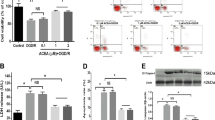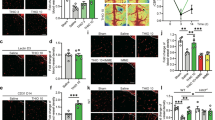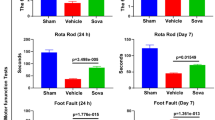Abstract
Cyclooxygenase-2 (COX-2), a rate-limiting enzyme for prostanoid synthesis, has been implicated in the neurotoxicity resulting from hypoxia-ischemia, and its inhibition has therapeutic potential for ischemic stroke. However, COX-2 inhibitors increase the risk of cardiovascular complications. We therefore sought to identify the downstream effectors of COX-2 neurotoxicity, and found that prostaglandin E2 EP1 receptors are essential for the neurotoxicity mediated by COX-2–derived prostaglandin E2. EP1 receptors disrupt Ca2+ homeostasis by impairing Na+-Ca2+ exchange, a key mechanism by which neurons cope with excess Ca2+ accumulation after an excitotoxic insult. Thus, EP1 receptors contribute to neurotoxicity by augmenting the Ca2+ dysregulation underlying excitotoxic neuronal death. Pharmacological inhibition or gene inactivation of EP1 receptors ameliorates brain injury induced by excitotoxicity, oxygen glucose deprivation and middle cerebral artery (MCA) occlusion. An EP1 receptor inhibitor reduces brain injury when administered 6 hours after MCA occlusion, suggesting that EP1 receptor inhibition may be a viable therapeutic option in ischemic stroke.
This is a preview of subscription content, access via your institution
Access options
Subscribe to this journal
Receive 12 print issues and online access
$209.00 per year
only $17.42 per issue
Buy this article
- Purchase on SpringerLink
- Instant access to full article PDF
Prices may be subject to local taxes which are calculated during checkout




Similar content being viewed by others
References
Simmons, D.L., Botting, R.M. & Hla, T. Cyclooxygenase isozymes: the biology of prostaglandin synthesis and inhibition. Pharmacol. Rev. 56, 387–437 (2004).
Hata, A.N. & Breyer, R.M. Pharmacology and signaling of prostaglandin receptors: multiple roles in inflammation and immune modulation. Pharmacol. Ther. 103, 147–166 (2004).
Minghetti, L. Cyclooxygenase-2 (COX-2) in inflammatory and degenerative brain diseases. J. Neuropathol. Exp. Neurol. 63, 901–910 (2004).
Chen, C. & Bazan, N.G. Lipid signaling: sleep, synaptic plasticity, and neuroprotection. Prostaglandins Other Lipid Mediat. 77, 65–76 (2005).
Niwa, K., Araki, E., Morham, S.G., Ross, M.E. & Iadecola, C. Cyclooxygenase-2 contributes to functional hyperemia in whisker-barrel cortex. J. Neurosci. 20, 763–770 (2000).
FitzGerald, G.A. COX-2 and beyond: approaches to prostaglandin inhibition in human disease. Nat. Rev. Drug Discov. 2, 879–890 (2003).
Topol, E.J. Failing the public health—rofecoxib, Merck, and the FDA. N. Engl. J. Med. 351, 1707–1709 (2004).
Manabe, Y. et al. Prostanoids, not reactive oxygen species, mediate COX-2-dependent neurotoxicity. Ann. Neurol. 55, 668–675 (2004).
Carlson, N.G. Neuroprotection of cultured cortical neurons mediated by the cyclooxygenase-2 inhibitor APHS can be reversed by a prostanoid. J. Neurosci. Res. 71, 79–88 (2003).
Bilak, M. et al. PGE2 receptors rescue motor neurons in a model of amyotrophic lateral sclerosis. Ann. Neurol. 56, 240–248 (2004).
McCullough, L. et al. Neuroprotective function of the PGE2 EP2 receptor in cerebral ischemia. J. Neurosci. 24, 257–268 (2004).
Ahmad, A.S., Ahmad, M., de Brum-Fernandes, A.J. & Dore, S. Prostaglandin EP4 receptor agonist protects against acute neurotoxicity. Brain Res. 1066, 71–77 (2005).
Suganami, T. et al. Role of prostaglandin E receptor EP1 subtype in the development of renal injury in genetically hypertensive rats. Hypertension 42, 1183–1190 (2003).
Hallinan, E.A. et al. Aminoacetyl moiety as a potential surrogate for diacylhydrazine group of SC-51089, a potent PGE2 antagonist, and its analogs. J. Med. Chem. 39, 609–613 (1996).
Audoly, L.P. et al. Identification of specific EP receptors responsible for the hemodynamic effects of PGE2. Am. J. Physiol. 277, H924–H930 (1999).
Nogawa, S., Zhang, F., Ross, M.E. & Iadecola, C. Cyclo-oxygenase-2 gene expression in neurons contributes to ischemic brain damage. J. Neurosci. 17, 2746–2755 (1997).
Caggiano, A.O. & Kraig, R.P. Prostaglandin E receptor subtypes in cultured rat microglia and their role in reducing lipopolysaccharide-induced interleukin-1β production. J. Neurochem. 72, 565–575 (1999).
Ladeby, R. et al. Microglial cell population dynamics in the injured adult central nervous system. Brain Res. Brain Res. Rev. 48, 196–206 (2005).
Iadecola, C. et al. Reduced susceptibility to ischemic brain injury and NMDA-mediated neurotoxicity in cyclooxygenase-2 deficient mice. Proc. Natl. Acad. Sci. USA 98, 1294–1299 (2001).
Sattler, R. & Tymianski, M. Molecular mechanisms of glutamate receptor-mediated excitotoxic neuronal cell death. Mol. Neurobiol. 24, 107–129 (2001).
Choi, D.W. Neurodegeneration: cellular defences destroyed. Nature 433, 696–698 (2005).
Funk, C.D. et al. Cloning and expression of a cDNA for the human prostaglandin E receptor EP1 subtype. J. Biol. Chem. 268, 26767–26772 (1993).
Randall, R.D. & Thayer, S.A. Glutamate-induced calcium transient triggers delayed calcium overload and neurotoxicity in rat hippocampal neurons. J. Neurosci. 12, 1882–1895 (1992).
Tymianski, M., Charlton, M.P., Carlen, P.L. & Tator, C.H. Secondary Ca2+ overload indicates early neuronal injury which precedes staining with viability indicators. Brain Res. 607, 319–323 (1993).
Khodorov, B. Glutamate-induced deregulation of calcium homeostasis and mitochondrial dysfunction in mammalian central neurones. Prog. Biophys. Mol. Biol. 86, 279–351 (2004).
Bano, D. et al. Cleavage of the plasma membrane Na+/Ca2+ exchanger in excitotoxicity. Cell 120, 275–285 (2005).
Annunziato, L., Pignataro, G. & Di Renzo, G.F. Pharmacology of brain Na+/Ca2+ exchanger: from molecular biology to therapeutic perspectives. Pharmacol. Rev. 56, 633–654 (2004).
Khodorov, B. et al. On the origin of a sustained increase in cytosolic Ca2+ concentration after a toxic glutamate treatment of the nerve cell culture. FEBS Lett. 324, 271–273 (1993).
Kiedrowski, L. N-methyl-D-aspartate excitotoxicity: relationships among plasma membrane potential, Na+/Ca2+ exchange, mitochondrial Ca2+ overload, and cytoplasmic concentrations of Ca2+, H+, and K+. Mol. Pharmacol. 56, 619–632 (1999).
Cho, S. et al. The class B scavenger receptor CD36 mediates free radical production and tissue injury in cerebral ischemia. J. Neurosci. 25, 2504–2512 (2005).
Acknowledgements
Supported by US National Institutes of Health (NIH) grants NS35806 and NS34179. C.I. is the recipient of a Javits award from NIH/National Institute of Neurological Disorders and Stroke. We thank B.H. Koller and S.L. Tilley for providing the Ep1−/− mice, L. Qian for studies in hippocampal slice cultures, C. Gooden for tissue cultures studies and C. Pardee for assistance with histology.
Author information
Authors and Affiliations
Corresponding author
Ethics declarations
Competing interests
The authors declare no competing financial interests.
Supplementary information
Supplementary Fig. 1
SC51089 is neuroprotective without influencing physiological parameters. (PDF 520 kb)
Supplementary Fig. 2
SC51089 reduces the hippocampal damage produced byoxygen-glucose deprivation but not microglial activation. (PDF 737 kb)
Supplementary Fig. 3
EP1 receptors are present in neurons. (PDF 9892 kb)
Supplementary Fig. 4
NMDA receptors, EP1 receptors, COX-2, and PGE2 synthase are present in neuronal cultures. (PDF 6158 kb)
Supplementary Fig. 5
Effect of SC51089 on the [Ca++]i elevation elicited by glutamate and on Ca++ currents. (PDF 735 kb)
Supplementary Methods
Methods for assessment of neurological deficits. (PDF 72 kb)
Rights and permissions
About this article
Cite this article
Kawano, T., Anrather, J., Zhou, P. et al. Prostaglandin E2 EP1 receptors: downstream effectors of COX-2 neurotoxicity. Nat Med 12, 225–229 (2006). https://doi.org/10.1038/nm1362
Received:
Accepted:
Published:
Issue Date:
DOI: https://doi.org/10.1038/nm1362
This article is cited by
-
Neuroinflammatory mediators in acquired epilepsy: an update
Inflammation Research (2023)
-
Transcriptome of human neuroblastoma SH-SY5Y cells in response to 2B protein of enterovirus-A71
Scientific Reports (2022)
-
Inducible Prostaglandin E Synthase as a Pharmacological Target for Ischemic Stroke
Neurotherapeutics (2022)
-
Alpha-Synuclein, cyclooxygenase-2 and prostaglandins-EP2 receptors as neuroinflammatory biomarkers of autism spectrum disorders: Use of combined ROC curves to increase their diagnostic values
Lipids in Health and Disease (2021)
-
Brain vulnerability and viability after ischaemia
Nature Reviews Neuroscience (2021)



